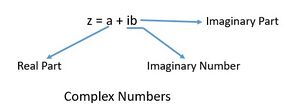Complex Numbers
Complex numbers are helpful in finding the square root of negative numbers. The concept of complex numbers was first referred to in the 1st century by a Greek mathematician, Hero of Alexandria when he tried to find the square root of a negative number. But he merely changed the negative into positive and simply took the numeric root value. Further, the real identity of a complex number was defined in the 16th century by Italian mathematician Gerolamo Cardano, in the process of finding the negative roots of cubic and quadratic polynomial expressions.
Definition
A complex number is the sum of a real number and an imaginary number. A complex number is of the form and is usually represented by .
Here both , are real numbers and . The value '' is called the real part which is denoted by , and '' is called the imaginary part . Also, is called an imaginary number.
Examples of Complex Numbers:
Representation of a Complex Number
The way Complex Number is represented is shown in the fig.1.
For example: , then
Real Part:
Imaginary Part:
Equality of complex numbers
Two complex numbers and are equal if and
Example: if where x and y are real numbers, then find the values of x and y.
Equating the real and the imaginary parts of we get
Hence
Answer: and
